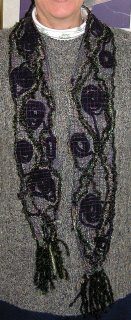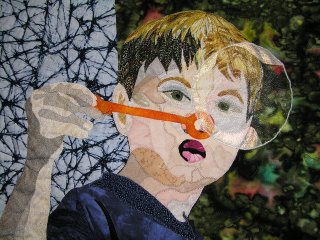

The thread scarf I made at Conversations in Cloth one night in August 2006.
The basic technique (very abbreviated) :
1. We used masking tape on the table to act as a template to keep the desired size and shape for the scarf.
2. Lay out a sandwich of water soluble stabilizer.
3. In between the stabilizer layers, threads, yarns, fibers, fabrics, scraps--anything that can be sewn-- are laid down in a desired pattern.
4. Use spray adhesive to hold everything in place
5. Sew! Sew! Sew!
6. Melt the stabilizer in water.
Presto! You have a treasured hand-made work of art!
The purple "globes" look like plums, or bunches of grapes, or even the eyes on the wings of a moth.
I used 12-wt. varigated quilting thread to hold the threads and yarns together. The heavier-weight thread has more body to hold the architecture. I don't worry about it catching on a snag and breaking. It's sturdy stuff!
 Here's the full view. I finished the background quilting. I still need to cut it down to size and add a binding.
Here's the full view. I finished the background quilting. I still need to cut it down to size and add a binding.








